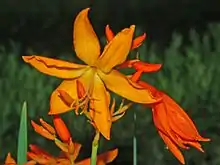Crocosmia
Crocosmia (/krəˈkɒzmiə, kroʊ-/;[2][3]), montbretia,[4] is a small genus of flowering plants in the iris family, Iridaceae. It is native to the grasslands of southern and eastern Africa, ranging from South Africa to Sudan. One species is endemic to Madagascar.[1]
| Crocosmia | |
|---|---|
 | |
| Crocosmia aurea | |
| Scientific classification | |
| Kingdom: | Plantae |
| Clade: | Tracheophytes |
| Clade: | Angiosperms |
| Clade: | Monocots |
| Order: | Asparagales |
| Family: | Iridaceae |
| Subfamily: | Crocoideae |
| Tribe: | Freesieae |
| Genus: | Crocosmia Planch. |
| Type species | |
| Crocosmia aurea | |
| Synonyms[1] | |
| |
.jpg.webp)
Description
They can be evergreen or deciduous perennials that grow from basal underground corms. The alternate leaves are cauline and ensiform (sword shaped). The blades are parallel-veined. The margin is entire. The corms form in vertical chains with the youngest at the top and oldest and largest buried most deeply in the soil. The roots of the lowermost corm in a chain are contractile roots and drag the corm deeper into the ground where conditions allow. The chains of corms are fragile and easily separated, a quality that has enabled some species to become invasive and difficult to control in the garden.
They have colourful inflorescences of 4 to 20 vivid red and orange subopposite flowers on a divaricately (horizontally) branched stem. The terminal inflorescence can have the form of a cyme or a raceme. These flower from early summer well into fall. The flowers are sessile on a flexuose arched spike. The fertile flowers are hermaphroditic. All stamens have an equal length. The style branches are apically forked. They are pollinated by insects, birds (sunbirds) or by the wind. The dehiscent capsules are shorter than they are wide.
The alternative name montbretia is still widely used. The genus name is derived from the Greek words krokos, meaning "saffron", and osme, meaning "odor" – from the dried leaves emitting a strong smell like that of saffron (a spice derived from Crocus – another genus belonging to the Iridaceae) – when immersed in hot water.[5]
Species
Species accepted by World Checklist of Selected Plant Families[1]
- Crocosmia ambongensis (H.Perrier) Goldblatt & J. C. Manning – Madagascar
- Crocosmia aurea (Pappe ex Hook.) Planch. (Falling Stars) – eastern + southern Africa from Cape Province to Sudan; naturalised in Azores
- Crocosmia × crocosmiiflora (Lemoine) N.E.Br. - South Africa; naturalised in parts of Europe, Rwanda, Zaire, Assam, Norfolk Island in Australia, Fiji, the Caribbean, Argentina, Tristan da Cunha (C. aurea × C. pottsii)
- Crocosmia fucata (Lindl.) M.P.de Vos – Kamiesberg Mountains in Cape Province of South Africa
- Crocosmia masoniorum (L.Bolus) N.E.Br. (Giant montbretia) – Cape Province, KwaZulu-Natal
- Crocosmia mathewsiana (L.Bolus) Goldblatt ex M.P.de Vos – Drakensberg Mountains in Mpumalanga
- Crocosmia paniculata (Klatt) Goldblatt (Aunt Eliza) – Lesotho, Swaziland, South Africa
- Crocosmia pearsei Oberm. – Lesotho, Free State, Drakensberg Mountains in Mpumalanga
- Crocosmia pottsii (Baker) N.E.Br. (Pott's montbretia) – Cape Province, KwaZulu-Natal
Garden hybrids
- Crocosmia × curtonus[6]
- Crocosmia × crocosmiiflora
Cultivation
Crocosmias are grown worldwide, and more than 400 cultivars have been produced. Some hybrids have become invasive, especially C. × crocosmiiflora hybrids, which are invasive in the UK, New Zealand, the American Pacific Northwest, and probably elsewhere.
Crocosmia are winter-hardy in temperate regions. They can be propagated through division, removing offsets from the corm in spring.
The following cultivars have gained the Royal Horticultural Society's Award of Garden Merit:
Other cultivars include:
- Crocosmia curtonus 'Lucifer', scarlet
Gallery
 Crocosmia × crocosmiiflora corms in winter
Crocosmia × crocosmiiflora corms in winter Close-up of Crocosmia 'Lucifer' in bloom
Close-up of Crocosmia 'Lucifer' in bloom Montbretia, south Manchester, England
Montbretia, south Manchester, England
References
- Kew World Checklist of Selected Plant Families
- "Crocosmia". Dictionary.com Unabridged. Random House. Retrieved 2016-01-23.
- "Crocosmia". Oxford Dictionaries UK Dictionary. Oxford University Press. Retrieved 2016-01-23.
- RHS A-Z encyclopedia of garden plants. United Kingdom: Dorling Kindersley. 2008. p. 1136. ISBN 978-1405332965.
- Manning, John; Goldblatt, Peter (2008). The Iris Family: Natural History & Classification. Portland, Oregon: Timber Press. pp. 144–47. ISBN 978-0-88192-897-6.
- Missouri Botanical Gardens
- "Crocosmia 'Hellfire'". RHS. Retrieved 5 May 2020.
- "RHS Plant Selector - Crocosmia 'Lucifer'". Retrieved 15 April 2020.
- "RHS Plant Selector - Crocosmia masoniorum". Retrieved 15 April 2020.
- "Crocosmia 'Paul's Best Yellow'". RHS. Retrieved 5 May 2020.
- "RHS Plant Selector - Crocosmia 'Severn Sunrise'". Retrieved 15 April 2020.
- "Crocosmia × crocosmiiflora 'Babylon'". RHS. Retrieved 5 May 2020.
- "RHS Plant Selector - Crocosmia × crocosmiiflora 'Star of the East' '". RHS. Retrieved 5 May 2020.
External links
| Wikimedia Commons has media related to Crocosmia. |
- De Vos, M. P. (1999) "Crocosmia". Flora of Southern Africa 7: 129-138.
- Peter Goldblatt, John Manning, Gary Dunlop, Auriol Batten - Crocosmia and Chasmanthe (Royal Horticultural Society Plant Collector Guide)
- Kostelijk, P.J. (1984) "Crocosmia in gardens". The Plantsman 5: 246-253.